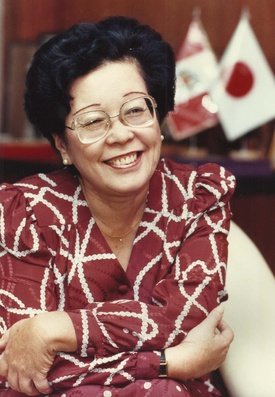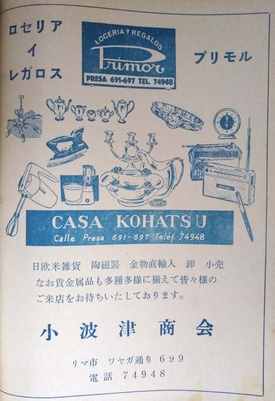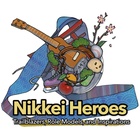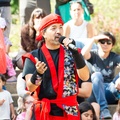
“By her works you will know her.” And because of their virtues, I think we can even come to admire a person. I was really surprised when I met Elena Yoshida from Kohatsu, the only woman who has directed almost all the institutions of the Peruvian-Nikkei community, such as the Peruvian Japanese Association.
But I have never met her in person; But that happened when he read books, listened to testimonies and memories and saw the commemorative plaques that perpetuate his memory. Even the library that preserves the history of our Nikkei community bears his name. So, how could it go unnoticed if we talk about Nikkei heroes! Elena Yoshida of Kohatsu stood out for her modesty and even preferred anonymity and if she could, she evaded tributes; although these virtues are now taken advantage of by those who would like to leave it forgotten. It has been 21 years since her departure and until now, she remains a hero among many Nikkei heroes.
The story begins in the city of Lima (Peru), on April 11, 1929, when Elena Miyoko Yoshida Nakamoto (her maiden name) was born. He studied primary school at the Lima Nikko Japanese school (17th class), and secondary school at the Great Rosa School of Santa María. From these times, there is an anecdote that I found in Discover Nikkei and that was shared by Keyko Higa through the journalist Enrique Higa Sakuda 1 , which dates back to the times of gakko (school). When Keyko was studying in Lima Nikko, she says that Elena used to take her to her house for lunch every time she saw her crying, because she had no place in the shokudo (dining room) at school. At that time, Elena was only in the fourth or fifth grade of primary school. That concern that Elena showed for her neighbors since she was a child later became her vocation.
For this reason, she wanted to be a doctor and when she finished school, she applied to the Faculty of Medicine at the Universidad Mayor de San Marcos; entering on the first try. But he only studied four years because he had to leave his degree due to family issues; although he never lost that concern to help others.
During the war, Elena was a Spanish teacher at Igei Gakuen, the school that Ginju Igei, the patriarch of the Nikkei community, opened clandestinely in Lince so that Nisei children would not be left without an education. 2 At that time, the Peruvian government had ordered the closure of Japanese schools due to Japan and its participation in World War II, so these gakuen operated clandestinely.

A few years later, in 1949, Elena married Taro Kohatsu. Together they started a family and had the remembered Locería y Regalos Primor, also known as Casa Kohatsu, which sold the famous Japanese Noritake tableware. With effort and work they opened several stores, like the first one in Lima (jirón Huallaga) and the last one in Lince.
But Mrs. Elena, as people called her out of respect and affection, was a proactive woman and was not satisfied with dedicating herself only to her husband, her children and her businesses. She began to serve the Nikkei community as a Fujinkai zonal delegate and, without seeking it, she began to highlight her innate leadership quality. Mentioning all the institutions he presided over would sound like presumption or exaggeration to some people; But it is necessary to refresh some of them and that we can find in writing in books and memoirs. 3, 4, 5 Elena Yoshida de Kohatsu was president of the Peruvian Japanese Women's Association (Fujinkai) in two periods (1971 and 1978) and of the Peruvian Japanese Association (1991), where she was the first and only woman to assume such a high position. post; achievement for which she is recognized until now.
Elena Yoshida of Kohatsu promoted the creation of the library that bears her name as well as the Ryoichi Jinnai Recreation Center for the Elderly, to which she dedicated love and focused empathy toward the koreisha (senior adults). The group of Shiawase volunteers who serve them and the home pick-up service (so that no ojichan or obachan is left wanting to go to their Jinnai) are the main contributions that Mrs. Elena included to this program. Likewise, his name is also remembered as one of the people who promoted the construction of the Japanese Peruvian Polyclinic (inaugurated in 1981), the work of the assistance committee of the Central Japanese Society (SCJ), chaired by Mr. Shozo Kitsuta. At the Polyclinic, Mrs. Elena was director for 10 years.
In addition to this impeccable career, we can mention other Nikkei institutions that benefited from the enthusiasm, vocation for service and leadership of Elena Yoshida, such as the Urasenke Association of Peru (from where she managed the arrival to Peru of the masters Sakuraba and Shirahase in 1974 to promote the practice of Chanoyu or Tea Ceremony), the Emmanuel Association, the Nikkei Cultural Foundation of Peru (which protects the heritage of Japanese immigrants through the Museum of Japanese Immigration to Peru “Carlos Chiyoteru Hiraoka”), the Peru Shimpo Editorial , the Lima Nikko Japanese School Alumni Association, the Commemorative Commission of the Centennial of Japanese Immigration, among others.
For her merits and successes, Mrs. Elena earned the admiration of those who knew her and for her extraordinary institutional career, she was decorated by the Japanese government in 1996. However, two years later, Elena Miyoko Yoshida of Kohatsu died, on January 26. February 1998. In 2012, the Museum of Japanese Immigration to Peru “Carlos Chiyoteru Hiraoka” inaugurated the temporary exhibition “Tribute to Elena Yoshida of Kohatsu”, where the life and works of the Nikkei leader were revived, showing photographs and personal objects as well as a recreation of a chashitsu (tea house), to represent one of her great hobbies: the chanoyu or tea ceremony, which she even perfected, reaching the rank of chanoyu teacher ( Jun-kyoju ) by the Urasenke School of Kyoto in Japan. In addition, she was fluent in Japanese and Spanish and since she was little, she was an assiduous reader.
21 years have passed since her departure and until now Mrs. Elena continues to be a guide and example of the qualities that a leader in our community should have: simplicity, modesty, enthusiasm, honesty, tenacity, a person of proactive character and firm decision. fair, with experience and vocation for service; as those who knew her in life agree.
Personally, I believe that she was a visionary woman who was ahead of her time, by assuming positions that until then (even now), were exclusively “for men only.” If we see the institutional photos of the time, we can see how Mrs. Elena stands out, being the only woman among gentlemen “in a coat and tie.” Personally, I would like her memory not only to remain in photos or commemorative plaques, but to be an example to follow, for being a heroine who did not wear a cape, but did have all the virtues to fly high.
Grades:
1. Enrique Higa “ Studying during the war ”, published on December 3, 2018 on Discover Nikkei .
2. Jorge Igei, director of the Carlos Chiyoteru Hiraoka Museum, in an interview I conducted for the newspaper Peru Shimpo on July 6, 2018: “Ginyu Igei, to the teacher with love.”
3. Daniel Oscar Tagata. Links II . 1998.
4. Peruvian-Japanese Association. Centennial of Japanese Immigration to Peru . 1999.
5. Okinawan Women's Association of Peru. XX Years.
© 2019 Milagros Tsukayama Shinzato






